 |
| November 28, 2017 | Volume 13 Issue 44 |
Designfax weekly eMagazine
Archives
Partners
Manufacturing Center
Product Spotlight
Modern Applications News
Metalworking Ideas For
Today's Job Shops
Tooling and Production
Strategies for large
metalworking plants
Wheels:
Sam Schmidt, a quadriplegic, races Corvette 190 mph
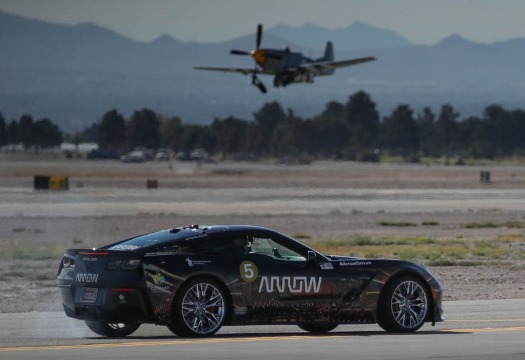
The Arrow Electronics SAM (semi-autonomous motorcar) car, a modified, 650-hp 2016 Corvette Z06 driven by quadriplegic racing legend Sam Schmidt, established a new record top speed of 190 mph on Saturday, Nov. 11, during a Veterans Day demonstration at Aviation Nation, the annual airshow hosted by the U.S. Air Force at Nellis Air Force Base in Nevada.
The new record is nearly 40 mph faster than the SAM car's previous speed record of 152 mph, which Schmidt set in 2016 during demonstration laps prior to the 100th running of the Indianapolis 500. That run used a modified SAM 2014 Corvette C7 Stingray (with 200 less hp than the new car).
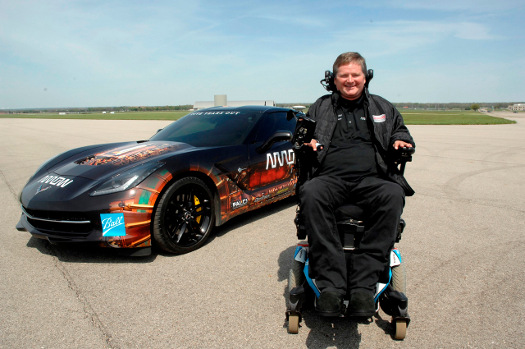
Driver Sam Schmidt and the modified semi-autonomous 2016 Corvette.
At Nellis, Schmidt completed three official demonstration runs down a two-mile-long runway, "racing" low-flying vintage and jet aircraft during each run.
Paralyzed from the chest down since a racing accident in 2000, Schmidt thought he would never drive again. In 2014, Arrow engineers modified a Chevrolet Corvette C7 Stingray to create a smart, connected vehicle with a human-to-machine interface that Schmidt can operate safely and independently using only the motions of his head. That model and its companion technologies have since been updated.
How the car works
The camera system
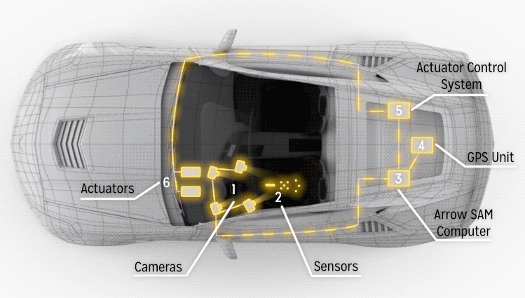
Infrared camera system: The driver wears a racing hat fitted with eight infrared sensors. Inside the car, four infrared cameras are mounted facing the driver. The cameras and sensors integrate into a system that can motion-track the driver's subtle head movements in real time.
The sensors mounted on the driver's hat reflect infrared light that is captured by cameras mounted on the car's dashboard and track the driver's head movement similar to green-screen computer animation systems used to develop characters in box-office movies.
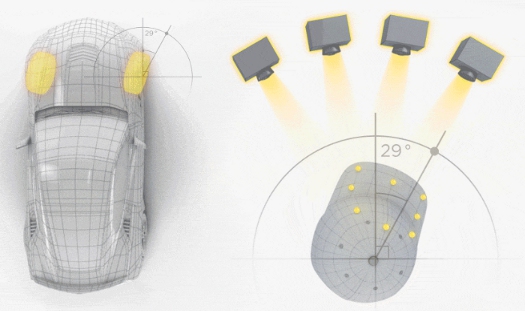
The cameras capture head movements left and right to steer the vehicle. The vehicle's windows have been tinted and feature infrared screening to optimize camera performance. In SAM 2.0, enhanced cameras, programming, and networking enabled more detailed recognition of the driver's head movements. These enhancements allowed the driver to navigate a complex road course.
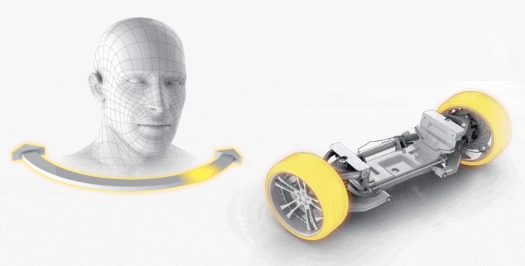
The sip/puff system
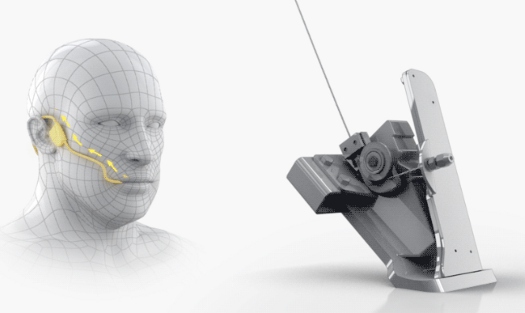
Sip/Puff switch control: The driver holds a device in his mouth, blowing air into a tube to accelerate and sipping air through the same tube to brake.
A tube is attached to the driver's head through a plastic mounting device that positions it conveniently in front of the driver's mouth. The tube is attached to a Freescale integrated pressure sensor. By blowing and/or sucking into the tube, the pressure sensor will instruct the system to apply the gas or brakes. No pressure results in the vehicle coasting.
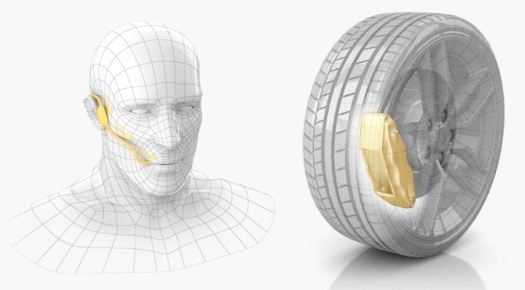
In version 1.0, the driver used the back of his head to press a sensor in the head rest, gradually accelerating in increments of 10 mph. In version 2.0, the driver puffs breath into a mouthpiece equipped with a Freescale pressure sensor, specifically selected to be sensitive enough to respond to Schmidt's input. The car responds directly via a rotary actuator attached to the gas pedal. The gas pedal is depressed based on the amount of air pressure the driver creates, giving him full control over acceleration -- from a smooth gradual increase to a quick burst of speed.
According to a Fox News Auto report, voice commands now enable the driver to switch gears and turn the car on and off.
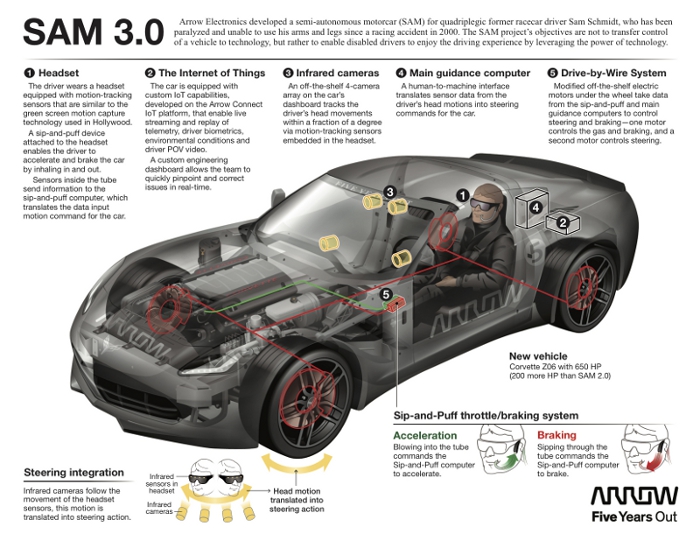
The GPS technology
As with standard global positioning systems, the SAM vehicle's GPS system tracks the car's movement according to a set path. However, the system in this vehicle is different from standard GPS systems in that the path is approximately 10 m wide, allowing the driver to steer within that range. The GPS system establishes "visual curbs" approximately 1.5 m from each edge of the track. The car is programmed to act according to the car's GPS location by warning the driver to correct course if it approaches the visual curbs. If the car continues to drift, the system gently auto-corrects the car to keep it on the track.
The safety system
A set of algorithms establishes real and defined limits for the vehicle to prevent unwanted head movements -- such as a sneeze -- to be translated by the computer system into unwanted driving commands.
The computer system
The control processor bringing all of the technology together to operate the vehicle includes one computer system interpreting data from the positioning system, camera system, and bite sensor, while a second camera system communicates instructions based on the data through actuators to control the vehicle's standard steering, acceleration, and braking systems. The communication between all systems occurs within milliseconds (the system updates 100 times per second) and is accomplished based on a series of software algorithms. In SAM 2.0, the control processors were upgraded to Freescale's I.MX Quad core technology to allow for faster data transmissions and more complex algorithm computing in a reduced power consumption and form factor. In SAM 3.0, custom IoT (internet of things) solutions enable real-time data streaming for managing telemetry, tracking driver biometrics, and monitoring environmental conditions.
"The theme of this year's airshow was ‘Breaking Barriers,' and that's what our SAM car project is all about: breaking barriers with technology," said Joe Verrengia, Arrow's global director of corporate social responsibility. "We want to highlight to the disabled veterans' community how technology can provide them with not only improved mobility, but also with inspiration and opportunities. We wanted to do our best for them, and to hit a new speed record on Veterans Day with the Air Force is definitely a proud moment for this project."
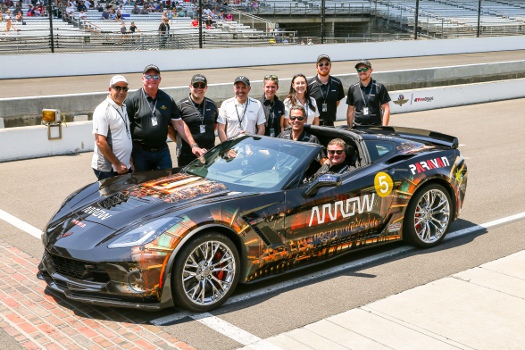
Driver Sam Schmidt and the Arrow SAM Project Team at Indianapolis Motor Speedway earlier this year.
VIDEO: Earlier this year, in May 2017, one of Sam's dreams came true: He finally got to race again, and he did it in grand fashion by racing Mario Andretti -- with Andretti using the SAM system in a car too! The race was run at Indianapolis Motor Speedway to benefit Conquer Paralysis Now, a nonprofit organization for spinal cord injury research and treatment founded by Schmidt. This was the first time two semi-autonomous cars have raced and the first time that Schmidt went head to head against another driver since his professional racing days.
Besides Arrow Electronics, partners in the ongoing project also include Freescale Semiconductor, Schmidt Peterson Motor Sports, and Conquer Paralysis Now (a nonprofit organization).
Learn more at community.arrow.com.
Source: Arrow Electronics
Rate this article
View our terms of use and privacy policy
